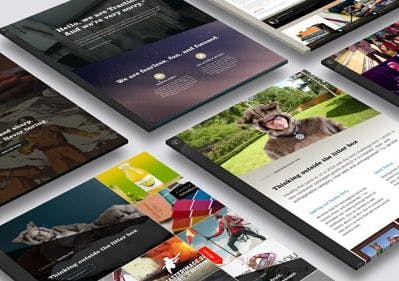Dissecting Omni-channel

By Adam Kleinberg
It was recently reported that 48% of retail CMO seats at the top 30 retailers have turned over in 2016. Diminishing CMO tenure has been in the news for years, yet that figure remains astonishing.
I recently had a conversation with my friend and former client at Bank of America, Ken Mowry. Ken is on the executive committee of the National Retail Federation and has held e-commerce leadership roles at a wide range of retailers including Sears, Kohl's, Lane Bryant, and currently Orvis. Ken described to me that "every retail CMO out there has been tasked with solving the omni-channel problem," but quite a few are still wrapping their head around what the word "omni-channel" even means.
That makes sense because omni-channel is an industry buzzword, and like so many other buzzwords in the marketing business, it's been bastardized and adopted to mean everything and nothing. And this doesn't just apply to omni-channel retail — all marketing is now omni-channel and most of the same observations apply.
There is No "Omni-Channel Problem" to Solve
Obviously, "omni-" means "all," but is using every channel at your disposal just for the sake of checking a box really an intelligent way to do things? Obviously, the task of "solving the omni-channel problem" is an omymoron, because omni-channel isn't a marketing objective, it is a solution. Marketing goals are things like driving sales, increasing market share, getting qualified leads, putting butts in seats, or improving Net Promoter Score. Omni-channel can be a means to that end, but it is not an end in and of itself.
To understand how CMOs in retail marketing—and other categories (turnover was highest in retail, but it was at a record high across the board)—should consider leveraging "omni-channel," to solve marketing goals, it makes sense to look at how the marketing puzzle has changed.
Why? Because good strategy starts with goals. The funnel used to be the planning tool that marketers used as a template for defining those goals, and then planning tactics to achieve them.
Essentially, the funnel has been squished. There are nuances to the customer journey in every category, but to simplify things, I'll share what a marketing director at another former client, Adobe, said to me a few years ago:
"We have two marketing objectives for everything we do here: Engagement and Conversion. "
Well, that certainly makes things simple. And it applies to omni-channel to because, the term essentially has two distinct definitions.
Omni-Channel Customer Experience
Gartner has reported that by the end of 2016, 89% of brand marketers polled said that their brands would compete primarily on the basis of customer experience. That is up from 38% two years before—a sea change.
The reason for this is straightforward. Advertising is becoming harder. People's attention is spread across more screens, more channels and sites, more distractions than ever before. They also are constantly connected and rely on one another to make decisions about brands more than ever before. That means marketers need to invest more in getting them to fall ga-ga in love with their brands to build loyalty, evangelism and preference to drive sales.
Omni-channel CX is all about providing content and experiences that provide value to people in some way or another to get them to to fall ga-ga in love with your brand. CX is the new branding.
Omni-channel CX can be defined as customer experiences that are consumable across all relevant touch points to your consumer—both digital and non-digital. I stress "relevant" because the trick here is not to throw every ingredient in the cupboard into the soup, but to create a seamless experience across the touchpoints that matter to your customer.
To be effective, an omni-channel CX should be a re-imaging of the customer journey based on insight. Insight, of course, comes from an understanding of your customer. In a recent post, Traction Senior Strategist, Lauren, McGehee, gave a number of examples of retailers creating experiences for customers based on the insight that people today expect and demand convenience.
It can also be a tool to solve business problems. We recently hepled a client who is well-known as a highly successful retailer overcome a problem for a product launch. Their business problem was that they had too many SKUs of a new, highly demanded product to keep it in inventory across their retail stores. We helped them build a fun, intuitive experience that spanned the web, email, text messages, mobile, e-commerce and retail environments to turn a challenge into a benefit. The result was that the potential problem was transformed into an enhanced brand experience.
Ironically, turning problems into opportunities has been an effective ad strategy since Bill Bernbach looked at a VW bug in a big car world, and said, "Think small." Today brand-building is just as important, if not more, than ever before—but brands can't fake it with advertising. Today, they need to provide better experiences and those experiences need to adapt to the fluid lifestyle of digital customers.
Omni-Channel Advertising
The other definition is the "get the right message in front of the right person at the right time and place" ambition to drive impact and sales with a single view of the customer. Many are claiming this is the holy grail of targeting as there are many studies showing that advertising is more effective when it reaches people across multiple touchpoints.
I stop short of "holy grail" because I still believe insight-driven creative is the actual holy grail. Omnichannel targeting is the next evolution of content distribution, but I'm less convinced that throw ads at someone's iPhone and television at the same time will change the fortunes of brands.
That said, I can get off my soap box and say that it will definitely make significant incremental impact in digital advertising effectiveness.
This is just beginnning to become possible. There is a convergence between ad tech and marketing tech taking place with new vendors allowing us to serve ads programmatically to clusters of individual prospects and customers. By segmenting them and customizing their communications more and more as they move farther down the funnel, we can serve more and more relevant messsages to them. More relevant ads mean more engagement, more conversion.
Programmatic TV is starting to come online, making this multi-touch approach even more appealing and potentially impactful. Of course, I have absolultely no expectation that people are going to start clicking on ads while watching television. But if we're thoughtful about how we message throughout the Customer Journey, we can get closer to the omnichannel dream.
If all this is confusing, consider this scenario.
- Alice is a brand marketer. Katie is a consumer. Alice programmatically serves up a hilarious video ad for a new toothpaste for cats to Katie as she's watching Empire on TV. Katie then gets retargeted with that same toothpaste ad seven times so that Alice is sure she's aware of it.
- Now that Alice knows Katie is aware of the cat toothpast, Alice tries to "engage" Katie with cute banner ads about kittens using toothpaste—Katie ignores them.
- Alice reminds Katie with tiny mobile ads of kittens using toothpaste on her phone when Katie checks Facebook—she ignores them too, but...
- When Katie logs onto Facebook on her laptop she sees the ads again and finally clicks because, ultimatley, Katie can't resist anything with that has to do with kittens.
- Coupons for cat toothpaste start following Katie around the internet and showing up once a week in her email inbox.
- Six months after seeing that first ad on Empire, Katie is going shopping because it's Friday and she always goes shopping on Friday. Alice knows this and sends her a mobile ad for a really extra good coupon shows up on her phone right as she pulls into the Safeway parking lot.
- Katie says "what the heck, I'll give it a shot!" and gives the cat toothpaste a try.
- Alice's attribution model uses Katie's Safeway Club card and an algorithm to update the dashboard on her desktop, prints out the report, and runs into her boss's office. Alice's boss smiles warmly and gives her a huge bonus.
Seems simple enough when you make it into a story about the consumer, but bringing it to life is a much different challenge. Attribution science is in its early years, which is why so many marketers rely on last-click attribution to justify marketing investments. As you see, the actual influence of ads on Katie's choice to try out cat toothpaste throughout her "journey" is complicated, difficult to assign relative value to, and extends far beyond that coupon.
Smaller marketers may be frustrated because any attribution model beyond last click requires scale to put in place. This makes it hard to empirically justify investments in their brands that smart marketers know they need to make. However, if they don't make those brand investments, they ultimately will not achieve the goals they set out to in the first place .
Larger marketers may be frustrated because if they limit their targeting to people they already know, they will not acquire new customers (case in point is P&G's decision to limit their use of Facebook targeted ads after realizing that the people who are likley to engage with digtial ads are not the only ones who need to buy toilet paper).
Perhaps, these help explain why CMOs are dropping like flies .
While the science of "omnichannel" is holds great potential, the application of it to solve business problems is an art.

Yes, retail is about convenience, ease, and seamlessness, especially when it comes to categories associated with utility.

Traction's work for Lenovo has made the Shortlist in the 2015 IAB MIXX Awards!

We’ve spent the last 15 years developing a wide variety of web apps and experiences for our clients and we’ve always taking that knowledge and packed it into our own web experiences.
